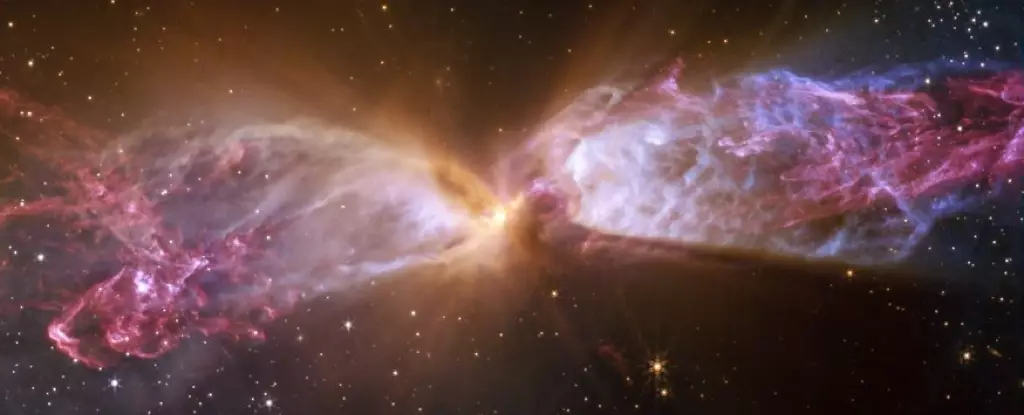In the grand tapestry of the universe, young stars represent the embodiment of fervent energy and tumultuous growth that can be likened to the unfiltered exuberance of childhood. Much like how a young child may express emotions wildly, newly formed stars exhibit their youthful dynamism through chaotic jet streams of gas and dust, reshaping their surroundings. The image captured by the James Webb Space Telescope (JWST) provides a stunning representation of this phenomenon, specifically in the region known as Lynds 483 (L483), located approximately 650 light-years from Earth. Here, amid dense cosmic fog, new stars are emerging, their power radiating throughout their environments in a spectacular display reminiscent of nature’s most artistic expressions.
The Birth of Stellar Giants
Stars are not solitary entities; they are part of a cosmic feeding frenzy. Young stars, or protostars, grow by voraciously accumulating surrounding gas and dust. Over the course of millions of years, this unending sustenance allows them to swell to staggering proportions. The largest identified stars can reach up to 200 times the mass of our Sun—a fact that is both awe-inspiring and intimidating. However, their existence is an intricate balance of accretion and ejection. As these stellar infants ingest matter, they also expel vast quantities of material back into the cosmos through formidable jets. This process is not merely a one-sided affair; rather, it represents the interplay of gravitational forces and magnetic fields in an eternal cosmic dance.
The Power of James Webb Space Telescope
The JWST stands as a monument to human ingenuity, surpassing its predecessors in sensitivity and resolution. Its ability to see further into the infrared spectrum allows us to unveil the hidden spectacles of star formation obscured by interstellar dust. It is akin to having an insightful mentor who can illuminate the darkest corners of our understanding. In the case of L483, the JWST penetrates the dense shroud of gas and dust, revealing not just the protostars but also the intricate structures they create. These structures weave an elaborate narrative of energy, chaos, and chemistry, appearing in rich patterns of color and swirl, symbolizing the dynamism of cosmic creation.
A Closer Look at Protostellar Jets
As young stars attract surrounding material, this matter forms swirling disks, known as accretion disks, around them. Yet, the fascinating mechanics of star formation do not end here. Powerful magnetic fields channel some of this material, ejecting it through the poles of the protostars. These jets, reaching impressive speeds of several hundred kilometers per second, are both intermittent and dynamic. They form intricate hourglass shapes where prior emissions collide with newer jets, leading to spectacular visual phenomena. The interplay creates clouds that are chemically rich and fertile, serving as incubators for complex organic molecules through chemistries that unfold in the heart of these stellar nurseries.
The L483 Mystery and Its Enigmatic Structures
Within the heart of L483 lies a captivating conundrum. The two protostars responsible for the chaos are shrouded in a band of thick dust, making them nearly invisible. However, the JWST reveals not just the stars but also a myriad of structures shaped by their energetic bursts. Flanked by orange cones of outflowing starlight and dark regions of dense dust, the optical complexity of L483 teases our scientific curiosity. For the first time, JWST’s infrared vision has documented filaments previously unseen, tangled and intricate, their functions still a mystery, inviting astronomers to ponder the role they play in the ongoing processes of star formation.
Future Implications for Astronomical Research
As researchers continue to analyze the data from JWST, they are poised at the cusp of discovery. The remnants of young stars like those found in L483 hold clues to the chemical evolution of our universe. Understanding how these chaotic forms of matter interact will impact our knowledge of planet formation and the emergence of life-sustaining elements. The complexity of L483, with both its symmetrical and asymmetrical features, paints a portrait of a dynamic environment that is still in flux. The proto-stars will one day shed their chaotic past and become stable, main-sequence stars, initiating a new chapter in their cosmic story.
As we contemplate the life cycles of these stars, we are also inevitably drawn to the prospect of future telescopes that may one day unveil even more complex truths about the universe around us. The journey from chaotic youth to structured adulthood is emblematic of growth, not just for stars but for the pursuit of knowledge itself. The universe has so many secrets waiting just beyond the horizon—not only about stars like those in L483 but about the very fabric of existence itself. Understanding young stars is not just about observing phenomena; it is about grasping the complexities of existence and the inexorable march of time within the cosmos.


Leave a Reply